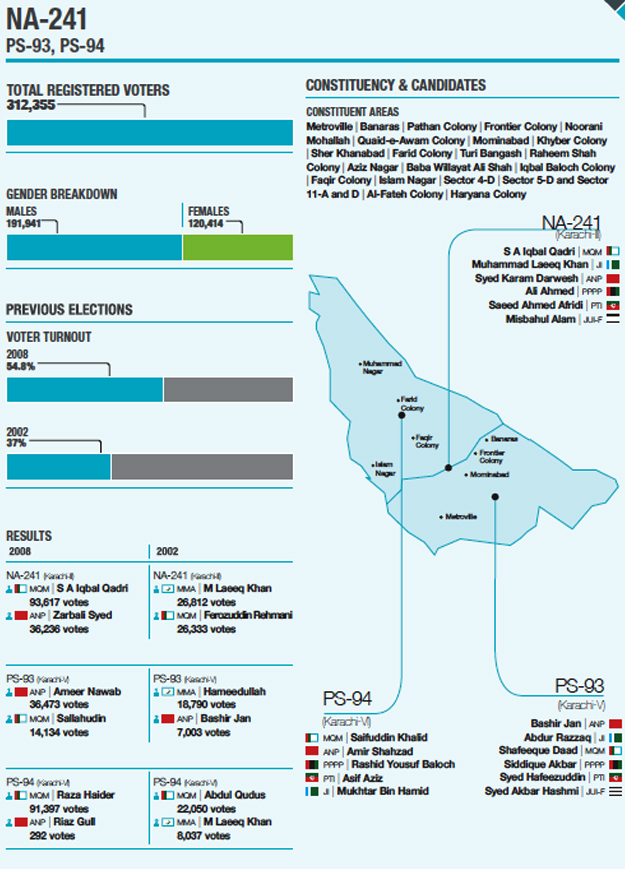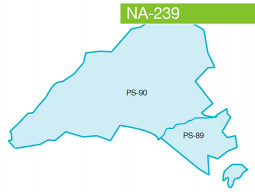
KARACHI:
If you flip through the pages of history, you will notice that the area which falls under NA-241 has seen a lot of bloodshed. Now, as the simmering ethnic violence backed by political groups begins to finally cool, a new menace has appeared in the form of the Tehreek-e-Taliban Pakistan (TTP).
Election campaigns in this constituency weren’t in full swing to begin with. But when a blast rocked ANP’s corner meeting in Mominabad last Friday, Awami National Party (ANP) and Muttahida Qaumi Movement decided to hit the brakes again.
Located in District West, the constituency covers areas of SITE Town as well as Orangi Town. Ethnically, NA-241 is very diverse: around 50 percent of its residents are from the Urdu-speaking community, 40 percent Pashtuns and the remainder comprises Baloch, Sindhi and Punjabis. Notorious for ethnic violence and target killings, the constituency is vulnerable to sectarian violence too. Members of the Shia community reside in areas of Irani Camp while members of the Sunni sect live in Islam Chowk.

Metroville, Mastan Chali, Bawani Chali, Pathan Colony, Banaras, Frontier Colony, Darwesh Mohallah, Ilahi Colony, Mominabad, Quaid-e-Awam and Turi Bangash are the areas where Pashtuns are in a majority. SITE Town’s Sector 4-D, 5-D and E, among others, are areas where the Urdu-speaking community are in a majority.
Glum in a slum
Parts of SITE - Pakistan’s largest industrial area with the biggest financial turnover - are found in NA-254. Though the constituency’s residents provide SITE and the rest of Karachi with the best skilled labour, a vast majority of them are on the lower rungs of the economic ladder.
During the day, they are the muscles of nearby factories. But when the sunlight fades, they return to katchi abadis which are bursting at the seams with a sea of semi-pucca structures. The unpaved, dusty and narrow lanes which snake through the area are lined with garbage. Overflowing drains form putrid puddles, also pointing to negligence.
Only 50 per cent of the population has access to potable water through taps, the rest depend on tankers. Though almost all areas of the constituency have electricity, voltage fluctuation is common and power cuts can last for up to 14 hours. Residents of shanty towns lament that because of the load-shedding, their homes get baked in the hot summer months.

The area’s literacy rate is 55.3 per cent, but the enrollment ratio tapers off along the higher grades and drops drastically after the Matric level. This is reflected in the fact that the constituency is home to only three government colleges. When it comes to state-sponsored healthcare facilities, the situation is even more dismal: there are no government hospitals in the constituency.
Down memory lane
Fazal Rehman, a 60-year-old man, has called Banaras his home for over 50 years. He says the area’s voters have changed the basis on which they give candidates their thumbs of approval.
“Earlier politicians used religion as a hook to fish for votes. But people of the area are now much more aware of their rights,” he says. “They ask politicians to show them development plans when they come to seek votes.”
The ghost of ethnic violence that plagued the area back in the summer of 2011 now looms large, adds Rehman.
“It has morphed the political arena in SITE and Orangi Town. Now, members of one ethnicity can’t move freely into areas dominated by the other,” he claims.
In such a situation, most political parties which are organised along ethnic lines have lost out as they can’t move about freely in some areas to muster support, he says.
“But the same constraints don’t apply to religious parties.”
Though the area has been historically violent, Rehman can recall the days when physical features weren't entry tickets to areas. The situation is a lot better these days, he admits. But the psychological scars are deep and people are always keeping an eye out.
Published in The Express Tribune, May 1st, 2013.
COMMENTS (4)
Comments are moderated and generally will be posted if they are on-topic and not abusive.
For more information, please see our Comments FAQ



































































So when the so-called religious parties can go into both the disparate ethnic areas, does it not show the triumph of religion over ethnicity?
Beautiful analysis. And, a treasure trove for sociologists and political analysts. Looking through a larger prism, it demonstrates the fault lines still being settled in the aftermath of the divisions carved during the Partition sixty five years ago. It will still take more time but settled it will, in one way, shape, or form. Thank you, Sohail Khattak, for an informative report.
“But the same constraints don’t apply to religious parties.” Why?
the residents of metroville receive water after every 17 days. No one bothers, now they ask for votes. The pic above of Bab e Khaybar is at the entrance of metroville, not frontier colony